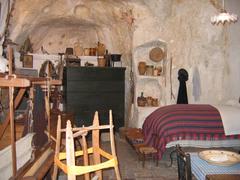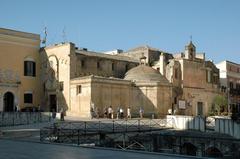Cave Churches of Matera: Visiting Hours, Tickets, and Historical Sites Guide
Date: 14/06/2025
Introduction: The Cultural Significance of Matera’s Cave Churches
Matera, located in southern Italy’s Basilicata region, is renowned for its ancient cave churches—known as “chiese rupestri”—carved directly into the tufa limestone of the Sassi districts. These sacred spaces are among the world’s oldest surviving examples of troglodyte settlements, reflecting an extraordinary continuum of human habitation, spirituality, and artistic achievement. With roots stretching back to the Paleolithic era and flourishing as sanctuaries for Byzantine and Benedictine monks during the Middle Ages, the cave churches of Matera are integral to the city’s cultural identity and recognized globally as a UNESCO World Heritage Site (UNESCO; Italia.it).
Visitors to Matera encounter not only the haunting beauty of these ancient churches, adorned with vibrant frescoes and architectural details blending Eastern and Western Christian traditions, but also the living legacy of a community that continues to celebrate its heritage through festivals, guided tours, and ongoing restoration (Sophisticated Travel; Modern Traveler).
Historical Overview: Evolution of Matera’s Cave Churches
Prehistoric Roots and Early Christianization
Archaeological evidence confirms continuous settlement in Matera for over 9,000 years, with early inhabitants using natural caves for shelter and ritual. By the 8th century, the migration of Byzantine and Benedictine monks fleeing iconoclasm transformed these caves into sanctuaries, establishing a local tradition of rock-hewn worship (Ancient Origins; TripJive).
Medieval Flourishing and Religious Life
Between the 9th and 13th centuries, Matera’s Sassi districts saw the emergence of more than 150 cave churches, many richly decorated with frescoes. These spaces became centers for worship, community gatherings, and artistic expression. Notable examples include:
- Santa Maria de Idris: Dramatically set atop a rocky spur, featuring panoramic views and biblical frescoes (Tourist Secrets).
- San Pietro Barisano: The largest cave church, with elaborate frescoes and burial niches (TripJive).
- Crypt of the Original Sin: Known as the “Sistine Chapel of cave churches,” with 8th–9th-century Genesis scenes (Tourist Secrets).
Decline, Rediscovery, and UNESCO Recognition
From the late Middle Ages, many cave churches fell into disuse or were repurposed. By the 20th century, the Sassi symbolized poverty, and residents were relocated. Restoration began in the 1980s and, in 1993, the Sassi and the Park of the Rupestrian Churches were designated a UNESCO World Heritage Site, sparking renewed preservation and tourism (UNESCO; Tourist Secrets).
Major Cave Churches and Historical Sites
Sassi Districts: Sasso Caveoso and Sasso Barisano
The Sassi neighborhoods are dense clusters of cave dwellings, cisterns, and churches, forming the urban heart of Matera’s rupestrian heritage (Momentslog).
Santa Maria de Idris & San Giovanni in Monterrone
Santa Maria de Idris is perched atop Monterrone outcrop, offering sweeping views and housing frescoes from the 12th–14th centuries. Internally connected, the San Giovanni in Monterrone crypt contains additional medieval artwork (OltrelArte Matera; The Road Reel).
Santa Lucia alle Malve
This former Benedictine convent, dating to the 9th–10th centuries, is famous for its three naves and a cycle of frescoes depicting the Madonna del Latte and other saints (Visit Italy).
Crypt of the Original Sin
Located in the Murgia Materana Park outside Matera, this crypt is accessible only by guided tour. Its early medieval frescoes are considered masterpieces of religious art (Italia.it).
San Pietro Barisano
Situated in Sasso Barisano, San Pietro Barisano is the largest cave church, featuring a three-nave interior, chapels, and rock-cut tombs (OltrelArte Matera).
San Pietro Caveoso
This church, with its stone façade and cave interior, overlooks the ravine and hosts important religious festivals (Wanderlog).
Madonna delle Virtù & San Nicola dei Greci
An interconnected complex in the Sassi, these churches are notable for their architecture, frescoes, and their use as venues for art exhibitions (Wanderlog).
Matera Cathedral
Though not carved into the rock, the cathedral dominates Civita Hill and is integral to understanding Matera’s religious history (Hotel Belvedere; Adventure Backpack).
Casa Grotta Museums
Museums like Casa Grotta di Vico Solitario recreate life in the Sassi, contextualizing the role of cave churches within daily community rhythms (The Road Reel).
Park of the Rupestrian Churches of Matera
This rural park contains over 150 rock churches, accessible by guided hikes and offering an immersive experience in natural and spiritual history (Visit Italy).
Visiting Hours, Tickets, and Access
Opening Hours
- Most cave churches: Open daily from 9:00 or 10:00 to 18:00 or 19:00, with seasonal variations. Last entry is typically 15 minutes before closing (OltrelArte Matera).
- Parco della Murgia Materana churches: Accessible only by guided tour; check specific schedules.
Ticket Information
- Entry Fees: Range from €2 to €10 per church. Combination tickets for multiple sites are available.
- Guided Tours: Essential for sites like the Crypt of the Original Sin and highly recommended for deeper historical and artistic context.
- Booking: Purchase tickets online via OltrelArte Matera or at tourist offices. Advance booking is advised, especially in peak seasons.
Accessibility
- Physical Access: The Sassi have steep, uneven stone paths; most cave churches are not wheelchair accessible.
- Mobility: Sturdy footwear is recommended. Guided tuk-tuk tours are available for those with mobility concerns (theurgetowander.com).
- Photography: Flash photography is generally prohibited to protect frescoes; always check site-specific policies.
Practical Tips for Visiting Matera’s Cave Churches
- Best Time to Visit: Spring and autumn offer pleasant temperatures and lighter crowds.
- Plan Ahead: Book tickets and guided tours in advance. Arrive early, especially at popular sites.
- Dress Code: Modest attire is required; shoulders and knees should be covered.
- Facilities: Limited public restrooms; use those in museums, cafes, or your hotel.
- Dining: Experience local cuisine in cave restaurants and sample Matera’s famous bread.
- Accommodation: Stay in a cave hotel for an immersive experience; book early during high season (Earth Trekkers).
- Safety: Cobblestones and steps can be slippery; supervise children and use handrails where available.
- Sustainability: Stay on marked paths, avoid touching frescoes, and support conservation efforts through entry fees or donations (Walks of Italy).
Enhancing Your Visit: Events, Visuals, and Local Culture
- Events: Check for concerts, exhibitions, and religious festivals, especially in San Pietro Caveoso and Madonna delle Virtù (ToursPilot).
- Photography Tips: Best exterior shots are in early morning or late afternoon for natural light. Respect no-flash and no-photo signs inside.
- Local Etiquette: Speak quietly, respect sacred spaces, and engage with local traditions for a richer experience.
Frequently Asked Questions (FAQ)
Q: What are the typical visiting hours for Matera’s cave churches?
A: Most are open from 9:00 or 10:00 to 18:00 or 19:00, with some seasonal variation.
Q: Are tickets required for entry?
A: Yes, most sites require tickets. Combination tickets and guided tours can be booked online.
Q: Is the Crypt of the Original Sin accessible independently?
A: No. It is only accessible via advance-booked guided tours.
Q: Are the cave churches wheelchair accessible?
A: Due to steep, uneven terrain, accessibility is limited.
Q: Can I take photographs inside the churches?
A: Photography is often restricted, especially with flash, to preserve frescoes.
Q: How long should I spend visiting the cave churches?
A: One day covers highlights; two to three days offers a more comprehensive experience.
Summary and Final Travel Tips
The cave churches of Matera are a testament to the city’s enduring legacy of faith, creativity, and adaptability. Carved through centuries of devotion and ingenuity, they offer visitors a unique journey through time—whether you are wandering the labyrinthine Sassi, admiring ancient frescoes, or participating in a local festival. For the richest experience, plan your visit with attention to opening hours, ticketing, and accessibility, and consider engaging with local guides and events. Support preservation efforts and respect these sacred spaces to ensure their continued vitality for generations to come (UNESCO; Modern Traveler; The Best Italy).
For more information, download the Audiala app for offline access to tours, maps, and up-to-date visitor information. Explore related guides and stay connected through official tourism platforms and curated travel resources.


